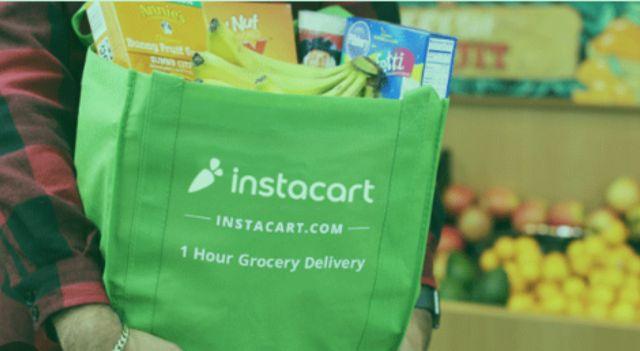The food delivery company Instacart (NASDAQ:CART) has priced its initial public offering (IPO) at the upper end of a previously announced range, raising $660 million in what constituted the second IPO in the US in just one week.
The San Francisco-based company managed to sell 22 million shares at $30 each yesterday, according to a statement. Instacart and existing shareholders had offered the shares between $28 and $30, a range that was raised after chip designer Arm Holdings surged 25% in its stock market debut on Thursday, marking the largest IPO of the year.
At the IPO price, Instacart now has a fully diluted valuation of $9.9 billion. This is a significant drop from its $39 billion valuation in a 2021 financing round when its business was growing amid store closures due to the pandemic, but it still ranks as one of the largest companies to go public this year.
Instacart’s IPO, combined with Arm’s, is also providing much-needed relief to the capital markets following the longest drought since 2009, at the height of the financial crisis. As a consumer startup backed by venture capital, success in its IPO debut could open the IPO market to other companies looking to go public.
Klaviyo, Birkenstock
Marketing and data automation service provider Klaviyo plans to sell its shares on Tuesday, and German shoe manufacturer Birkenstock Holding is also preparing to go public.
Even with Instacart’s IPO and Arm’s $5.23 billion offering, which now includes the so-called greenshoe shares, only about $21 billion has been raised on US stock exchanges this year, according to data compiled by Bloomberg. This figure is similar to the $22 billion raised last year but is still less than one-tenth of the $250 billion raised in 2021, a record-breaking year, according to the data.
Pricing Decision
Instacart decided on Monday to price its shares at $30 or higher, Bloomberg News reported. Like Arm, which also considered pricing its shares above the negotiated range, Instacart ultimately chose not to exceed the terms offered.
Following Arm’s example, Instacart also secured major investors to support its share price. PepsiCo will purchase $175 million in convertible preferred shares of Instacart. The company also enlisted Norway’s Norges Bank, TCV, Sequoia, D1 Capital Partners LP, and Valiant Capital Management as lead investors who could acquire up to 60% of the shares, according to its prospectus.
Instacart’s largest investors include Sequoia Capital and D1 Capital Partners, according to the company. Other investors include Tiger Global Management and Coatue Management, according to PitchBook.
The IPO is led by Goldman Sachs and JPMorgan Chase, with the participation of Bank of America Corp, Barclays, and Citigroup, along with 15 other underwriters.
Instacart, which was incorporated as Maplebear, sold 14.1 million shares in the IPO, with existing shareholders selling 7.9 million, according to the statement. The company’s shares will begin trading on Tuesday on the Nasdaq Global Select Market under the symbol CART.
Founded in 2012, Instacart faced a rapid slowdown in the growth of its core business in the wake of the pandemic and has been seeking new ways to make money.
Advertising Boost
Orders on its platform increased 18% to nearly 263 million in 2022 but remained virtually flat in the first half of 2023 compared to the previous year, Instacart said in its filings. The company managed to be profitable in 2022, in part thanks to increased advertising revenue, which now accounts for almost a third of the company’s total revenue.
Despite a flattening of orders, the gross transaction value increased by 4% to $14.9 billion in the first half of the year. Instacart is also able to retain more profit from each order. Net profit grew as a percentage of gross transaction value, with a profit of 1.5% in 2022 replacing a loss of 0.3% in 2021.
Fidji Simo, CEO of Instacart and a Facebook veteran, took over from co-founder Apoorva Mehta two years ago and helped Instacart move beyond food delivery and focus more on behind-the-scenes technology, leveraging the massive amount of consumer data it collects to help grocery stores sell more. Simo overhauled Instacart’s business model and expanded the range of products the company can sell to grocery stores, from analytics software to delivery services, 15-minute delivery promises, and advertising platforms.
By equipping physical supermarkets like Kroger and Wegmans with e-commerce technology, alongside Instacart’s existing online presence, Simo is betting that the company will grow whether people browse the app at home or pick up tomatoes in-store.
The company has also explored new revenue streams, such as catering services and supplying food to small and medium-sized businesses, including preschools and corporate offices, as well as health services to provide food and nutrition programs through hospitals, medical service providers, and insurers.
Although Instacart still dominates most of the market for orders over $75, DoorDash has been gaining market share in lower-value orders, as shown in Instacart’s records. DoorDash, which went public in 2020, has a market value of about $31 billion. Instacart also competes with Uber Eats and Amazon’s food delivery service, which includes Whole Foods, and with Walmart’s growing e-commerce capabilities.
